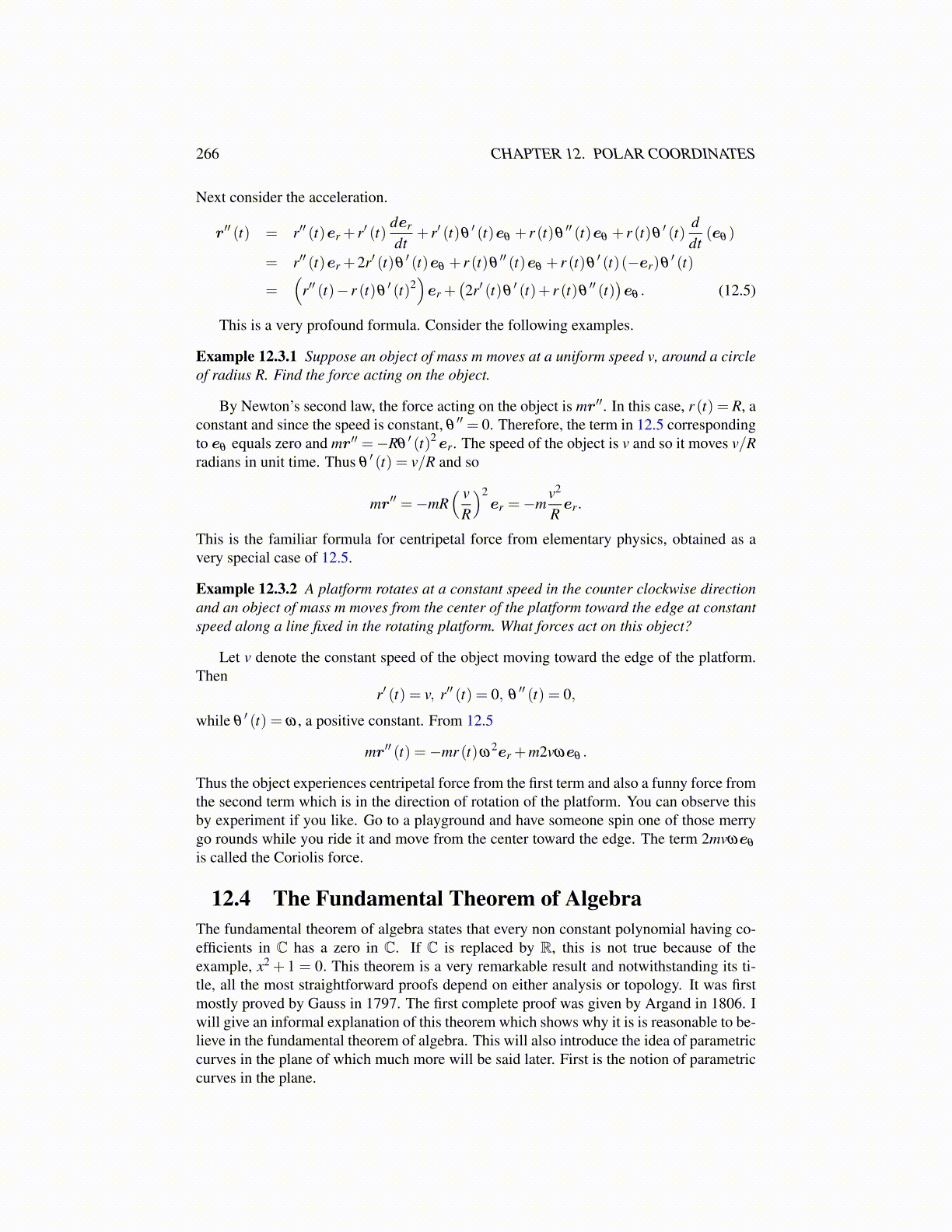
266 CHAPTER 12. POLAR COORDINATES
Next consider the acceleration.
r′′ (t) = r′′ (t)er + r′ (t)der
dt+ r′ (t)θ
′ (t)eθ + r (t)θ′′ (t)eθ + r (t)θ
′ (t)ddt
(eθ )
= r′′ (t)er +2r′ (t)θ′ (t)eθ + r (t)θ
′′ (t)eθ + r (t)θ′ (t)(−er)θ
′ (t)
=(
r′′ (t)− r (t)θ′ (t)2
)er +
(2r′ (t)θ
′ (t)+ r (t)θ′′ (t)
)eθ . (12.5)
This is a very profound formula. Consider the following examples.
Example 12.3.1 Suppose an object of mass m moves at a uniform speed v, around a circleof radius R. Find the force acting on the object.
By Newton’s second law, the force acting on the object is mr′′. In this case, r (t) = R, aconstant and since the speed is constant, θ
′′ = 0. Therefore, the term in 12.5 correspondingto eθ equals zero and mr′′ =−Rθ
′ (t)2er. The speed of the object is v and so it moves v/Rradians in unit time. Thus θ
′ (t) = v/R and so
mr′′ =−mR( v
R
)2er =−m
v2
Rer.
This is the familiar formula for centripetal force from elementary physics, obtained as avery special case of 12.5.
Example 12.3.2 A platform rotates at a constant speed in the counter clockwise directionand an object of mass m moves from the center of the platform toward the edge at constantspeed along a line fixed in the rotating platform. What forces act on this object?
Let v denote the constant speed of the object moving toward the edge of the platform.Then
r′ (t) = v, r′′ (t) = 0, θ′′ (t) = 0,
while θ′ (t) = ω , a positive constant. From 12.5
mr′′ (t) =−mr (t)ω2er +m2vωeθ .
Thus the object experiences centripetal force from the first term and also a funny force fromthe second term which is in the direction of rotation of the platform. You can observe thisby experiment if you like. Go to a playground and have someone spin one of those merrygo rounds while you ride it and move from the center toward the edge. The term 2mvωeθ
is called the Coriolis force.
12.4 The Fundamental Theorem of AlgebraThe fundamental theorem of algebra states that every non constant polynomial having co-efficients in C has a zero in C. If C is replaced by R, this is not true because of theexample, x2 + 1 = 0. This theorem is a very remarkable result and notwithstanding its ti-tle, all the most straightforward proofs depend on either analysis or topology. It was firstmostly proved by Gauss in 1797. The first complete proof was given by Argand in 1806. Iwill give an informal explanation of this theorem which shows why it is is reasonable to be-lieve in the fundamental theorem of algebra. This will also introduce the idea of parametriccurves in the plane of which much more will be said later. First is the notion of parametriccurves in the plane.